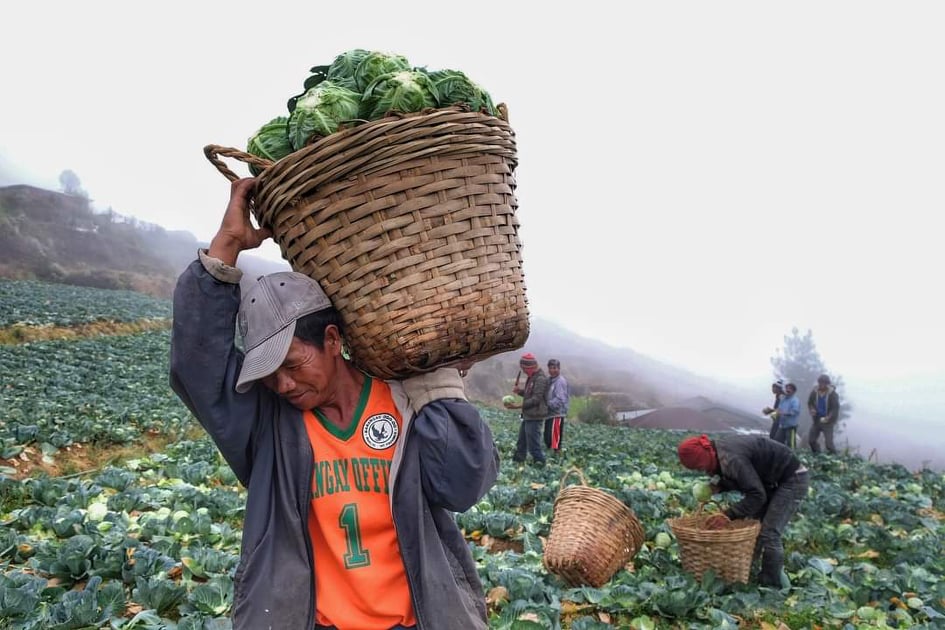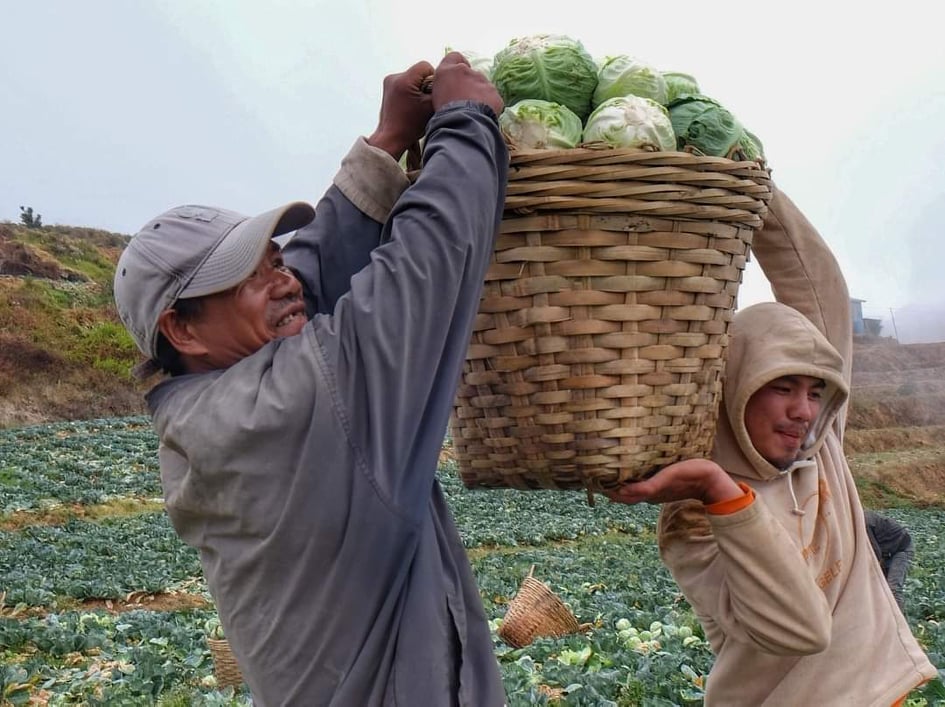By Henrylito D. Tacio
Photos by Rhoy Cobilla
Cabbage is one of the most popular vegetables in the market due to its affordability, local availability, and nutritional aspects. It grows mostly in places where there is long, cool weather like Benguet and Mountain Province.
The Cordillera Autonomous Region is the top producer with 20.51 thousand metric tons or 81.1% of the country’s total output from April to June this year, according to the Philippine Statistics Authority. Central Visayas and Ilocos Region followed with 5.0% and 3.4%, respectively.
In Davao Region, cabbage can be grown in Mount Apo, the country’s highest peak (at 9,692 feet). It is now part of Mount Apo National Park, which was established in 1936. It features numerous peaks, valleys, falls, lakes, and hot springs.
It’s only in recent years that farmers learned that cabbage could be grown at Mount Apo’s rolling hills. Today, it is a common sight to see commercial gardens of cabbage, carrots, and potatoes at the foot of the iconic mountain.
Some environmental groups find this development alarming as Mount Apo is now devoid of its forest cover. Trees were being cut to give way to commercial gardens of high-value crops. As a result, some parts of the mountain are now bald, which are visible even from the highway.
The Davao-based Kapwa Upliftment Foundation, Inc. sounded the alarm as early as 2019. “(Mount Apo) is now bald and what we see these days are gardens of cabbage, potatoes and carrots,” said Miraflor Joy Austria, Kapwa project coordinator.
When he was still the secretary of the Department of Agriculture, Emmanuel Piñol attended the launch of the potato project in the area. When asked about the problem, the former agriculture chief said that it was alright to plant cabbage as long as farmers followed the contour method of farming.
“Dapat repolyo-cacao-kape to balance lang,” Austria quoted Piñol as saying. “Hindi naman natin maalis ang mga repolyo growers kasi may mga laborers na doon na dependent na sa mga pananim.”


On a clear cool day, cabbage farmers in Atok, Benguet are busy harvesting their vegetables. Photos by Rhoy Cobilla
The contour method of farming Piñol cited is actually the Sloping Agricultural Land Technology (SALT), which the Mindanao Baptist Rural Life Center (MBRLC) in barangay Kinuskusan of Bansalan, Davao del Sur developed.
“When you plant vegetable crops like cabbage in sloping areas, the biggest problem you encounter is soil erosion,” explains Jethro P. Adang, MBRLC director. “Soil erosion is minimal when there is a forest cover. The leaves of the trees stabilize the impact of the raindrops.”
Now, if trees are cut and the land is planted to vegetable crops, then the topsoil – considered the primary resource in farming – is eroded when there is heavy rain. “Without topsoil, farming is not sustainable,” Adang says.
But soil erosion can be curtailed by planting two hedgerows of different nitrogen-fixing species like kakawate, ipil-ipil, flemingia, and rensonii.
“We are following the principle of the rice terraces in Ifugao,” Adang says. “But instead of rocks, we plant shrubs. The eroded topsoil is gathered in the foot of these shrubs. This means the topsoil is not eroded but transferred in the lower portion. As years go by, the area becomes flattened. The result: natural terraces.”
In SALT, the crops are planted in between the hedgerows. “We recommend cutting the hedgerows every month or so in order not to shade the crops,” Adang says. “The cuttings are not thrown anywhere but placed at the foot of the crops and serve as mulching materials. Once the cuttings are rotten, they become fertilizer to the crops as the leaves are rich in nitrogen, phosphorus and potassium.”
To make SALT farms sustainable, permanent crops are planted every third or fourth strip. Recommended permanent crops are cacao, coffee, and black pepper (which uses live kakawate as trellis).
For encouraging international utilization of SALT and other sustainable farming systems of MBRLC, former director Harold Ray Watson earned the Ramon Magsaysay Award for international understanding in 1985.
Watson was hailed for helping stop soil erosion in the uplands by promoting the SALT systems. In addition, SALT farms provide decent income to farmers who follow the system.
Now, if only those Mount Apo farmers will only follow the contour method of farming, they can plant cabbage and other high-value crops as long as they want. Besides, there is always a ready market for cabbage as it has an impressive nutrient profile.
Cabbage is known in the science world as Brassica oleracea. Aside from cabbage, the Brassica genus comprises various other leafy vegetable cultivars, including broccoli, Brussel sprouts, garden cress, cauliflower, collard greens, mustard, turnips, and bok choy, to name a few.
Most Filipinos know only of green cabbage, but red and purple cabbages also exist. The leaves can be smooth or crinkled. The shape of its head can be classified into three groups: ball head, conical, and large drumhead.
One good thing about cabbage is that they are not easily rotten, unlike other vegetables. In conditions under 32 degrees Fahrenheit with 95% relative humidity, cabbage may keep for as long as five months.
Cabbage is commonly eaten as a vegetable. In some instances, however, people use the leaves for stomach pain, excess stomach acid, and stomach and intestinal ulcers. It is also used to treat asthma and morning sickness.
In some instances, breastfeeding women, according to rxlist.com, apply cabbage leaves and cabbage leaf extracts to their breasts to relieve swelling and pain.
Cabbage contains protein, fiber, folate, manganese, calcium, potassium, and magnesium. It also contains small amounts of other micronutrients, including vitamin A, iron, and riboflavin.
Cabbage is packed with vitamin C and vitamin K. Also known as ascorbic acid, vitamin C serves many important roles in the body. Vitamin C is needed to make collagen, the most abundant protein in the body. It likewise helps the body absorb non-heme iron.
Vitamin C is a powerful antioxidant. As such, it protects “the body from damage caused by free radicals, which has been associated with many chronic diseases, including cancer,” writes healthline.com’s Jillian Kubala.
Cabbage is a terrific source of vitamin K1, delivering 85% of the recommended daily amount in a single cup (89 grams). One of its main functions is to act as a cofactor for enzymes that are responsible for clotting the blood.
“Without vitamin K, the blood would lose its ability to clot properly, increasing the risk of excessive bleeding,” Kubala writes.
Because of its high vitamin K content, cabbage may interact with blood thinner Coumadin (warfarin).
The US Academy of Nutrition and Dietetics recommends cabbage and other cruciferous vegetables to help maintain strong cognitive function with age. “Memory and alertness levels can be improved with good nutrition,” verywellfit.com states. “The nutrients in cabbage help optimize blood flow to the brain. Cabbage is beneficial for people of all ages who want to stay sharp.”

